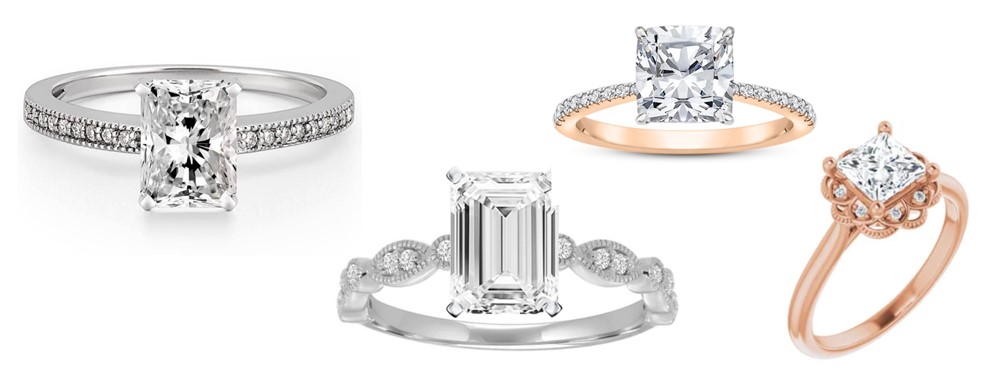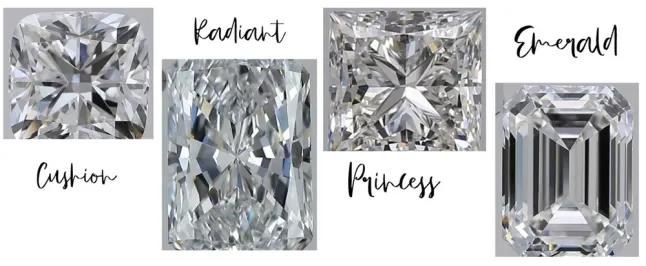It's Hip to be a Square: The Guide to Square Shaped Diamonds | Rare Carat
Square-cut diamonds are the edgier (pun very much intended), rebellious sisters of the round brilliant-cut diamond. While the round brilliants are the most common cut of diamond, square diamonds follow close behind. A diamond’s beauty is impressive no matter what shape it's in, but these rockin’ rocks in a square-cut shape really show them off.
Now, there's a handful of cut styles in square. Some square, others more rectangular, some with corners, others without. We’ll go over the most common ones and what exactly to look for when searching for your square-stunner.
P.S. Before we get ahead of ourselves, here's a little info on some of the lingo we'll be using
Length-to-width ratio: This measurement is calculated by dividing the length of the diamond by the width. These measurements are very important for proportions. While these small millimeter differences may not seem like a big deal, they are going to be what makes a square diamond look uneven or awkward, and also to allow proper faceting to let all the brilliance shine through. There are very strict cutting guidelines that are used for the intended diamond shapes, and if not followed, you get a mis-faceted stone.
 The diamond on the left has misaligned facets, on the right is very good, pleasing cut. See the difference the cut makes in the brilliance and scintillation?
The diamond on the left has misaligned facets, on the right is very good, pleasing cut. See the difference the cut makes in the brilliance and scintillation?
Table percentage: This calculation is done by dividing the table width (the very top of the diamond) by the diameter. This is also an extremely necessary measurement because if the table percentage is too low, light may get trapped inside the diamond, leak out the sides and won't be returned through the table.
If the table is too high, light won't refract (reflect) off the facets and this will cause you to have a very dull looking diamond, even if it is otherwise a good clarity grade.
Depth percentage: Found by dividing the depth by the diameter. This is how deep the diamond is, and can be more or less deep depending on the style. This comes into play when choosing the carat size of the stone to visual appearance, sometimes more depth is required for the cut style and therefore makes the diamond appear smaller because there is more weight in the bottom of the stone to achieve the correct faceting.
Princess
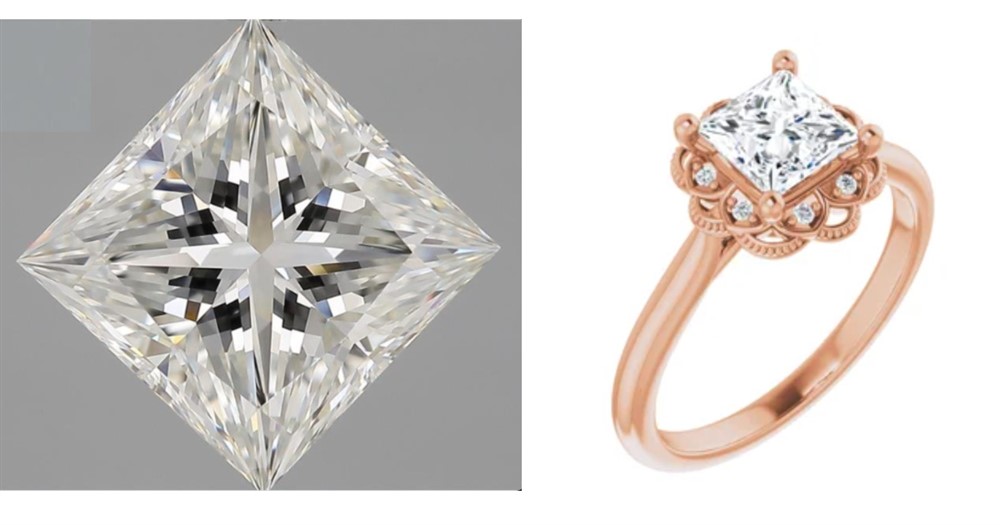
This will be the most classic square cut out of the bunch. At first glance, this is a very sharp-cornered square with stunning brilliance. Its sparkle is thanks to its 57 facets modeled after a round brilliant.
While some of these cuts can have a generous variance in L/W ratio being uneven, this one is definitely the exception to the rule. Princess cut diamonds MUST be even on all 4 sides to really be aesthetically pleasing. This is supposed to be a very true square shape, and if two sides are slightly longer than the others, it will throw the whole facet pattern off and you won’t achieve the sharp, visually impressive look we’re going for. So this is something to be mindful of when purchasing. Ideally, you’re looking for 1.00 to 1.04. Very slight variance, but any more than this and you’ll start getting into rectangle territory.
For the table percentage, you’re looking for 62-72%. This is very crucial to having a sparkling diamond that doesn’t just look like a piece of glass. If the table is too wide, there won’t be enough light returning to you visually and it will look empty internally and not very diamond-like at all.
 See how much of a difference the light dispersion makes?
See how much of a difference the light dispersion makes?
While we’re on the topic of tables, this is a pretty big one in diamond standards. That means if you have a good clarity stone, you’ll have plenty of opportunities to see all the fire, brilliance and scintillation your diamond has to offer. However, a larger table means more room to see imperfections, called inclusions. These may be carbon specs or crystals that got stuck internally while the diamond was forming, or others such as clouds (groupings of inclusions that can cause the diamond to look hazy) twinning wisps (where the diamond's planes twisted together, looking like zebra stripes internally) or even feathers (tiny fractures). This misfit bunch of unwanted nuisances can be very obvious in a diamond with a larger table because they are easier to spot and can ruin the whole stone if they are in very inconspicuous spots.
While almost all diamonds will have some kind of inclusions (after all, diamonds, like us, are very, very rarely perfect) some have them in areas that are less noticeable. And that's what you want to look for is a good, eye-clean stone, and if it does have inclusions, they aren't sticking out at you like a sore thumb.
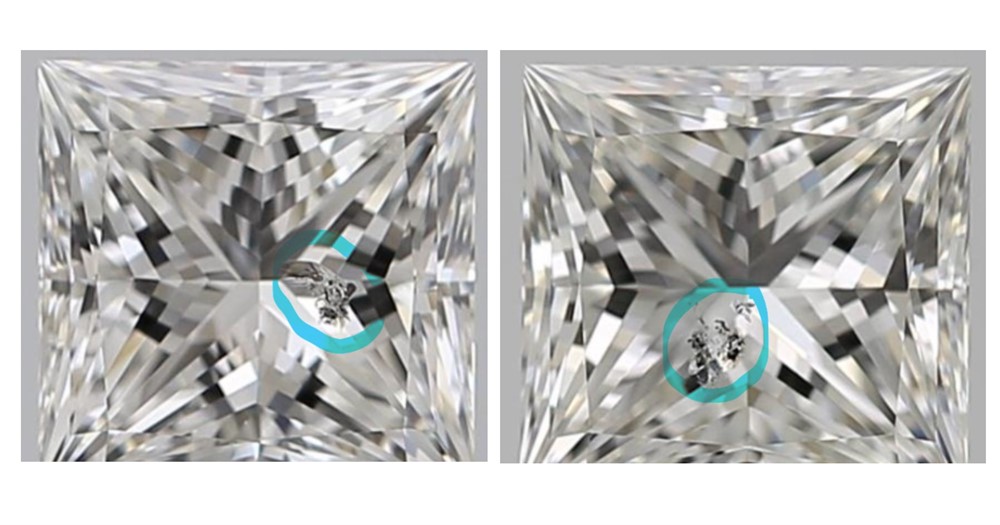
The depth percentage we’re looking for here will be 64-75%. This will give you optimal brilliance and refraction. With the square shape, there is slightly more weight needed in the bottom of the diamond, meaning the carat weight you get may not actually look quite as large as say a round brilliant. This means for the size you want, you may have to look for a slightly larger carat weight. On the other hand, since the shape is square, it will already look larger on your finger due to the corners. So really, it may even itself out, but that's up to you, always look for the diamond you think fits you best and not the carat weight.
Okay, so princess cut we need a 1.00 to 1.04 length to width ratio, table percentage around 62-72%, depth percentage of 64-75%, and no obvious inclusions in the table.
Got it - on to the next one!
Asscher
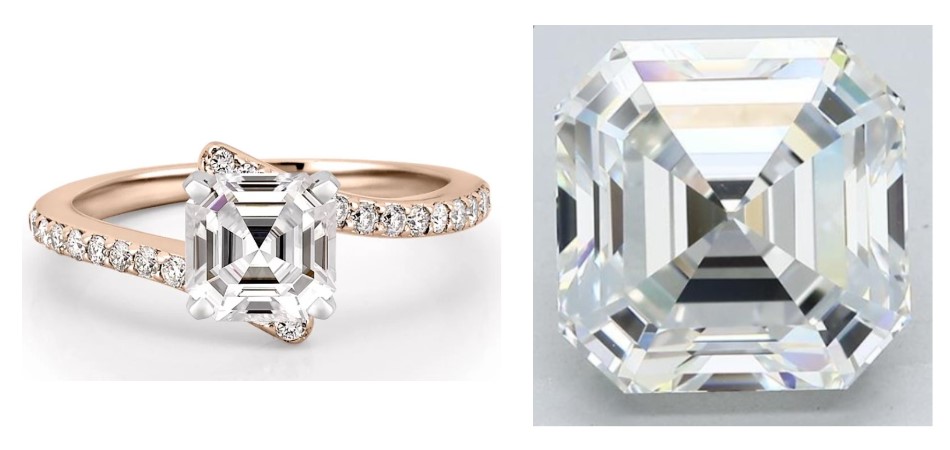
Talk about a classic! This cut originated in 1902 by the Asscher brothers from Holland. It's popularity peaked unfortunately in the '20s, so it's a common find in antique stores and estate sales. But, as many vintage trends have been making a comeback, in the early 2000s there was a modified version that is the Asscher cut we know and love today.
At first glance, you have a pretty even square that has somewhat deeply cropped corners so it can make it look a little octagonal. It has the long chiseled facets of an emerald, but because of a higher crown and smaller table, this produces lots of brilliance. Keep in mind, this is a pretty deep cut stone. So that means you may need to find a stone over the carat weight you're looking for to get the visual representation you actually want on your finger.
You'll be watching out for a table percentage of 55-65% Depth percentage of 60-68% And a L/W ratio of 1.0-1.03
Cushion

Ah, the cushion cut diamond, the softer, more comfy-looking friend of the Princess cut. Okay, maybe that sounds silly, but this one is literally named after the shape of a pillow… so I feel like that description holds up. These are generally square to slightly rectangular in shape with softer, rounded corners.
One of the really cool things this cut style offers is the way they are faceted, they return more fire (flashes of color) to your eye. So if that's your favorite part of a diamond, this is a great style for you. There are even a few variations to a cushion so you can find one that really fits your fancy.
Cushion cut comes in 3 variations - old mine cut, modified brilliant, and crushed ice (nope, not a typo... you'll love it don't worry).
The old-mine-cut is over 200 years old and It has 58 facets making it look a little… well... chunky (yes, the technical term is chunky facets).
The modern cushion has 64 facets, giving it a slightly more refined sparkle.
And then we have the crushed ice cushion. Stay with me here, it's actually quite intriguing. Imagine getting a glass of water and adding crushed ice to it, there's a way cushions are cut that are reminiscent of this visual. This is due to extra facets being cut beneath the girdle (middle) to create more reflections and sparkle.
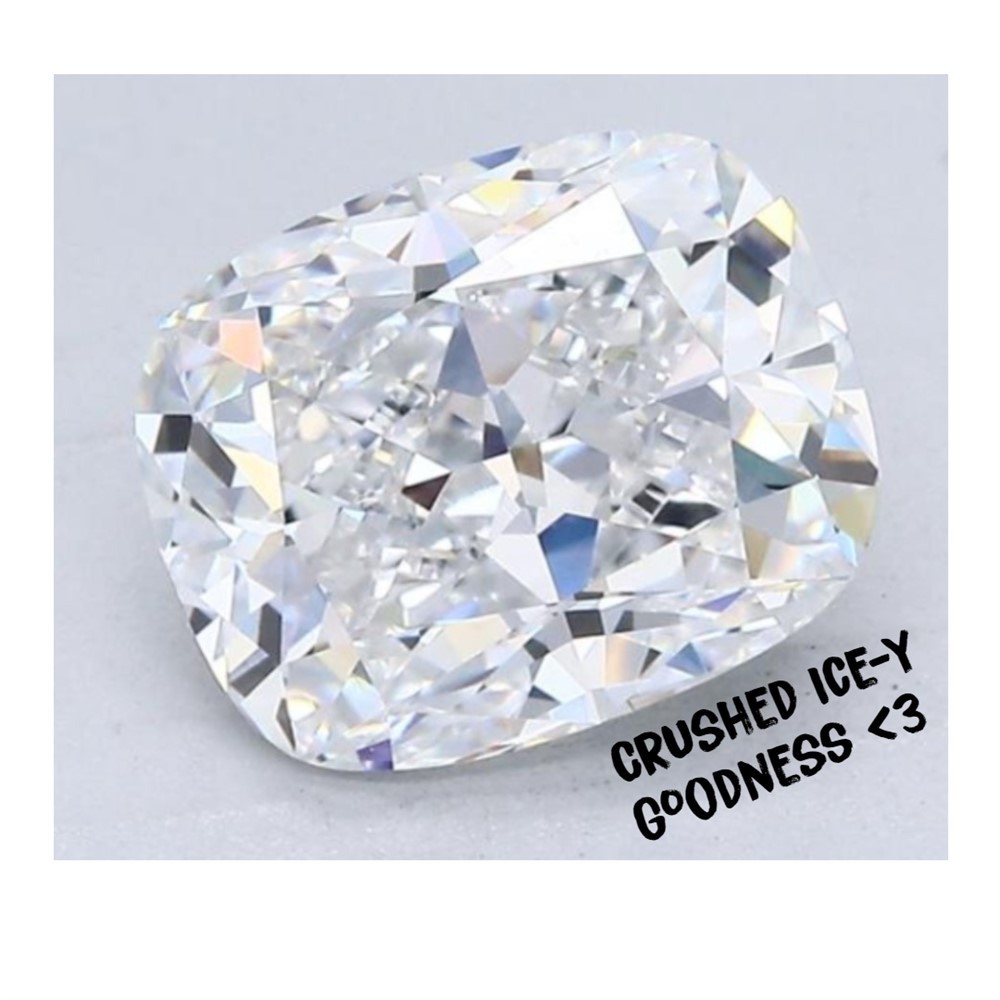
Similar to the princess cut, this style needs a little more weight in the bottom to really have the best refraction, and that’s okay. We like our diamonds with a little junk-in-tha-trunk as long as they are looking their best.
Here are the optimal measurements for these guys: L/W ratio of 1.0-1.05 for a more square, 1.15-1.30 for a more rectangular shape. 61-68% depth percentage and 55%-65% for the table percentage.
Radiant
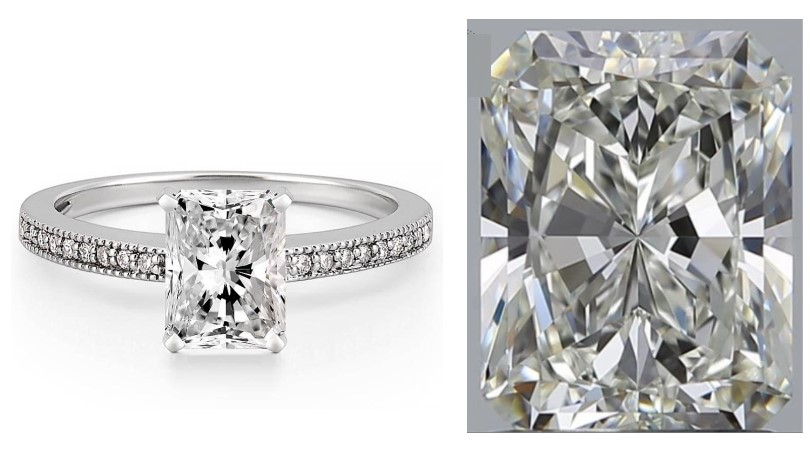
Isn’t that the most attractive name for a diamond? Radiance is exactly what you want, and will get with this cut. This cut is the love-child of an Emerald and a brilliant cut. So you have the rectangular shape with beveled corners, and the brilliance and sparkle of a round brilliant. This creates a very nice alternative if you don’t dig an emerald's chiseled facets or a brilliant's round shape. Best of both worlds!
This cut has either 66 or 70 facets (depending on if the corners are cropped off or not) and can range from square to rectangular. There’s a ton of options here, so you can really find the ratios that call to you.
There's a lot of range for our ratios here depending on the shape you’re looking for. Anything close to 1.0 will be more square and can go all the way up to 1.50 to give you a definite rectangular shape.
Table percentage and Depth percentage here is going to be between 61%-69%
Emerald
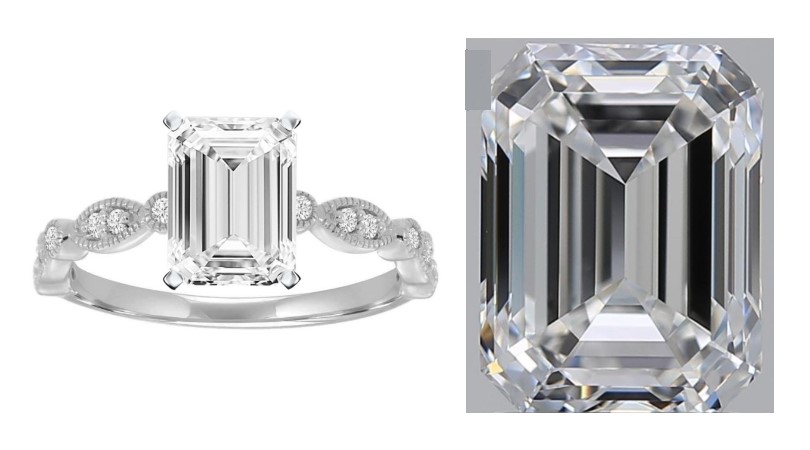
And last but certainly not least, we have our emerald cut. While technically this isn’t a square (a rectangle is a square but a square isn’t a rectangle? Something like that... I didn’t pay attention that day in math class…) we’re still going to give it its square-ish shaped credit.
An Emerald cut is reminiscent of the art-deco area, with very vintage-y vibes. This classy and elegant cut will consist of a very obvious rectangular shape, with two longer and two shorter sides, and (usually) beveled corners. It has sleek, chiseled facets that create an effect called the “hall of mirrors” due to the reflections mirroring off each other that seem to go on forever.
While this cut is stunning, the emerald cut will give off less brilliance than its other, more faceted friends. While this is by no means usually a deal-breaker, it's something to remember when shopping for your glitzy diamond. You’ll still have little bits of color showing, but it won’t be as much as a brilliant cut.
This means with a less refractive diamond cut, you gotta watch out for those inclusions. It is seriously hard to hide those unwanted features in an emerald cut, since it is so easy to see internally without almost any obstruction. This is one cut you really have to make clarity a priority - even though a round brilliant that is slightly included can be almost undetectable, an emerald with the same clarity rating can be massively obvious. If you are looking for an emerald cut, its worth the extra money to find on that has a great clarity grade.
 There's nowhere to hide inclusions in these bad boys
There's nowhere to hide inclusions in these bad boys
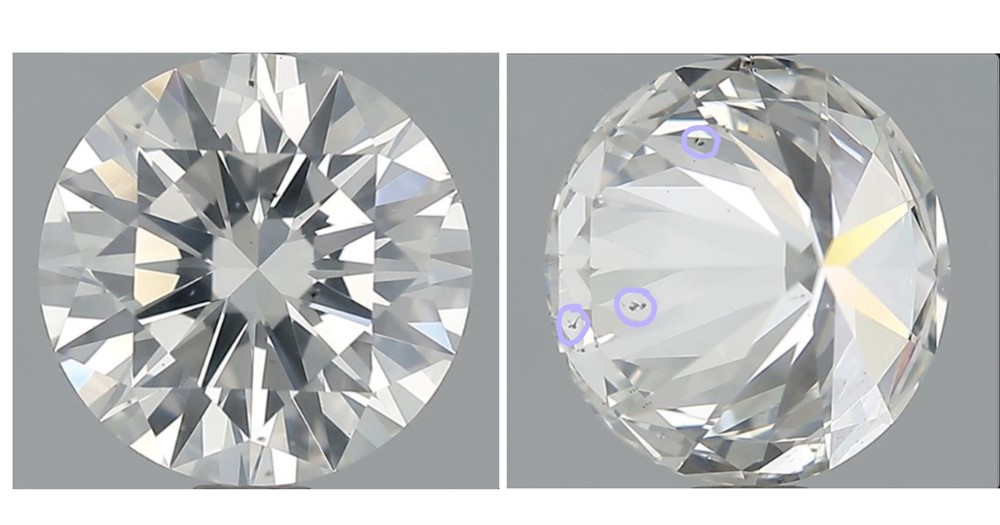
This is the same clarity grade (SI2, slightly included second degree) in a round brilliant. Look at how there are still inclusions, but the facets mask them.
The ideal length to width ratio for an emerald cut is 1.30, however, this can vary all the way from 1.20 -1.50 depending on how rectangular you really want the stone to be.
Table percentage will be between 60%-68% Depth percentage you want to be at 60%-67%
So there you have it friends, your guide to square (and sometimes rectangular) diamonds. Keep those ratios in mind when searching for your dream diamond, they can really be the make-or-break it for some cuts. Keep your eye out for those pesky inclusions smack-dab in the center of the table, we don’t want eyesores to sour those admiring glances to your diamond. So go on now, go shop with all your square-cut knowledge and find your diamond!
